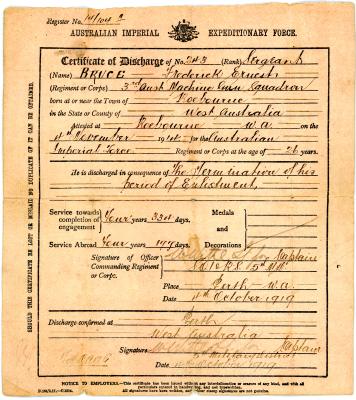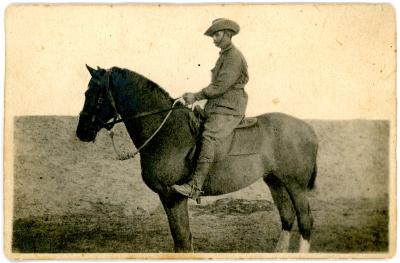First World War Improvised Identity Discs Sergeant Frederick Ernest BRUCE 243
1914 - 1918Two (2) small round improvised Identification discs made from Egyptian 50 Piastres coins hung from a metal chain. One side of each disc is the original coin and the other has been ground flat and the soldier’s details engraved on it. Each coin has had a hole made for a small ring that the chain passes through. The chain has a round clasp.
These discs are engraved with the name Frederick Ernest BRUCE 243. Frederick came from Cossack in the north of Western Australia and enlisted on 4 November 1914. He joined 10th Light Horse Regiment as a Private and his unit sailed from Fremantle aboard the HMAT A47 Mashobra on 17 February 1915. He served at Gallipoli and then in Palestine and was promoted to Sergeant in January 1918. Sargeant BRUCE returned to Australia on 10 July 1919. The A.M.G.S. engraved on the discs stands for Australian Machine Gun Squadron who provided fire support for the Australian Light Horse Brigade in the Middle East.
Details
Details
Disc one obverse “F E BRUCE / 243 / 3RD A.M.G.S. / C. E. and reverse 5 / Piastres / 1915”
Disc two obverse “F E BRUCE / 243 / 3RD A.M.G.S. / C. E. and reverse 5 / Piastres / 1917”
During the First World War identity discs were issued to those serving in the Australian Imperial Force (AIF). In August 1914, orders were circulated that each man wear an identity disc showing his name, number (if relevant), unit, and religion. Only other ranks had service numbers, officers did not.
In late 1916 Australia adopted the British regulation to issue each member of the AIF with two discs, both made of compressed fibre: an octagonal green disc and a circular red disc Given that it was over two years from the declaration of war until the Department of Defence finally ordered two discs be worn, many soldiers had a fear that they may be unidentified if they were killed. This fear could have contributed to large numbers of Australians wearing unofficial commercially produced or improvised identity discs in addition to their officially issued disc. Discs made from ground down foreign coins were particularly popular.
Open in Google Maps
Nearest geotagged records:
- Invalid Cup (0km away)
- Peter LONEY Letter (0km away)
- Ellis SILAS Water Colour Painting (0km away)
- Engraved Japanese Water Bottle belonging to Robert George Staunton RENNIE WX7493 (0km away)
- Enlistment Poster (0km away)
- W. D. & H. O. Wills Lace Flag Cigarette Cards (0km away)
- First world War Picture Postcard (0km away)
- Photograph of the Japanese surrender to Australia on 13 September 1945. (0km away)
- Engraved Tin given to Major Arthur Robinson HOME WX11151 (0km away)
- Martini-Henry action (0km away)
Nearby places: View all geotagged records »
Princess Royal Fortress Military Museum
Princess Royal Fortress Military Museum
Other items from Princess Royal Fortress Military Museum
- 1908 Belgium 25 Centimes Pierced Coin Sergeant Frederick Ernest BRUCE 243
- Framed Marriage Photograph Sergeant Frederick Ernest BRUCE and Elsie Eva BRUCE (nee HARRIS)
- First World War Certificate of Discharge Sergeant Frederick Ernest BRUCE 243
- 'Weapons of Precision' Metal Tin used by Private William John BEER 512
- First World War Cut Throat Razor “The Clinker” used by Private William John BEER 1509
- First World War 'Kropp' Cut Throat Razor used by Private William John BEER 1509
- First World War T. R. Cadman & Sons Cut Throat Razor used by Private William John BEER 1509
- First World War Medal Trio Ribbon Bar of Pte. William John BEER 1509
- First World War Cut Throat Razor used by Private William John BEER 1509
- Leather Razor Strap Used by Private William John BEER 1509
- First World War Bullets and Barbed Wire Found at Gallipoli, Turkey
- First World War Black and White Postcard of Sergeant Frederick Ernest BRUCE 243
Scan this QR code to open this page on your phone ->


